 |

|
| |
Hispanic Outreach:
Delivering the Safety and Health Message |
| |
As part of a nationwide effort, OSHA is exploring
new ways to reach Hispanics in the Lone Star state.
by Kathryn Delaney
|
| |
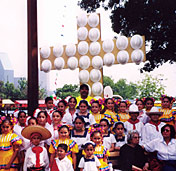 OSHA's Dallas Area Office staff noticed a disturbing trend in fatal accidents for 1999. Twenty-six construction workers died that year in Northeast Texas, compared with 19 in each of the 2 previous years and 13 in 1996. A jump in the number of Hispanic and Latino construction workers killed was even more startling: increasing from 15 percent of construction fatalities in 1996 and 1997 to 60 percent by the end of 1999. OSHA's Dallas Area Office staff noticed a disturbing trend in fatal accidents for 1999. Twenty-six construction workers died that year in Northeast Texas, compared with 19 in each of the 2 previous years and 13 in 1996. A jump in the number of Hispanic and Latino construction workers killed was even more startling: increasing from 15 percent of construction fatalities in 1996 and 1997 to 60 percent by the end of 1999.
Leaders in the local construction community saw the same deadly pattern and quickly joined with OSHA's Dallas, TX, safety specialists to find better ways to make construction worksites safer. A first step was a series of stakeholder meetings in January 2000. Participating contractors and safety professionals identified many factors as impediments to construction safety, but they rated the problems of meeting the safety needs of Spanish-speaking workers as one of their toughest.
In an earlier measure to address this problem, our colleagues in Forth Worth had begun regularly scheduled 10-hour construction courses, which targeted small employers, in both English and Spanish in the Fort Worth-Dallas area. While this was a solid step forward, we knew that the Dallas staff needed to take more action to meet the community's needs and reverse the current upward trend in fatal accidents.
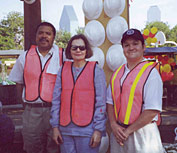 Everyone left the January 2000 stakeholder meetings committed to making a difference in construction safety. Employers aggressively sought bilingual safety trainers for their employees and classes in Spanish language instruction for construction supervisors became popular. Some employers began to promote and even sponsor English classes for their Hispanic and Latino employees. Everyone left the January 2000 stakeholder meetings committed to making a difference in construction safety. Employers aggressively sought bilingual safety trainers for their employees and classes in Spanish language instruction for construction supervisors became popular. Some employers began to promote and even sponsor English classes for their Hispanic and Latino employees.
We also modified our way of doing business. Compliance officers throughout the Dallas-Fort Worth area took conversational Spanish classes. OSHA used every opportunity to increase public awareness of the need for safety on the job and to outline resources available to help meet that need. We reached out to contractor associations, took our message to every training session, and worked with the media to get the word out about making construction workplaces safe. The staff viewed every inspection as another opportunity to educate people about construction safety. And we worked with colleagues from the OSHA Fort Worth Area Office to offer additional 10-hour construction safety courses.
As our efforts continued, we garnered more support from employers. For example, two trade associations, the Associated Builders and Contractors (ABC) and Associated General Contractors of America (AGC), added Spanish to their safety resources. We noticed that employers reporting program improvements were using bilingual consultants. The Texas Engineering Extension Service, the OSHA Training Institute Southwest Education Center, launched an aggressive program to offer the OSHA 500 Trainer Course for the Construction Industry in Spanish. This helped increase the number of qualified trainers in the area.
OSHA awarded a Susan Harwood Training Grant to support this program and another for the North Texas Chapter of the Associated Builders and Contractors to provide Spanish training in the four major hazards associated with construction fatalities.
Taking another avenue to improve safety, OSHA developed a solid working relationship with the General Consul of Mexico, located in Dallas, to mobilize support for increasing safety for Hispanic and Latino construction workers.
In early 2000, employers called us to ask for sources of bilingual safety training. By late 2001 they were calling to let OSHA know about the Spanish training they were willing to make available to others. And we witnessed increased interest from Hispanic and Latino safety professionals in obtaining Spanish-language publications and curriculum materials.
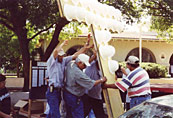 The critical indicator of improvement was the substantial decrease in fatal accidents. By December 2001, construction fatalities in Northeast Texas had fallen nearly 50 percent, to 13 for the year. And the percent involving Hispanic and Latino workers dropped from 60 percent to 40 percent. The critical indicator of improvement was the substantial decrease in fatal accidents. By December 2001, construction fatalities in Northeast Texas had fallen nearly 50 percent, to 13 for the year. And the percent involving Hispanic and Latino workers dropped from 60 percent to 40 percent.
The idea that a diverse group of people could make such a dramatic difference to their community created a lot of enthusiasm, especially because many had presumed others in the group to be adversaries. The question, "Can industry, safety professionals, and OSHA make a difference?" had become, "How much of a difference can a committed community make if they continue to work together?" Once again, we turned to stakeholders for answers.
Eugene Freeman, compliance assistance specialist for the Dallas Area Office, networked with hundreds of people to set the stage for a successful stakeholder meeting. Many of the faces at the March 1, 2002 meeting were different from those seen 2 years earlier. In addition to construction representatives, the group now included representatives from service and immigration groups and officials from the Mexican Consulate. Joe Reina, Deputy Administrator for the Dallas Regional Office, joined a spirited and bilingual discussion of key safety issues faced by Hispanic and Latino workers.
"The greatest part of our stakeholder meeting," Freeman observed, "was the active participation by Spanish-speaking people. We all came together to make a concerted community effort to solve this problem."
The group pointed out the need for more Spanish-language training and safety services. Most of the meeting's attendees, however, believed that a critical part of the safety message was not reaching even the Hispanic and Latino workers being trained. Information on what safety equipment to use and how to follow safety procedures was readily available, but what wasn't was a culturally meaningful explanation of why safety was important. What significance could safety equipment and procedures play in the lives of people struggling to provide for their families while adjusting to life outside their homelands?
To this end, Hispanic and Latino community members at the stakeholders meeting explained the importance of safety to their peers with a message that was meaningful in both language and culture.
As one result of this meeting, we told our compliance officers to provide details of accidents that happened when workers failed to take safety measures being discussed. A real attention grabber was the 35-footlong memorial list that OSHA personnel unrolled, with the names of 81 Hispanics and Latinos killed on the job.
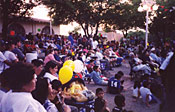 Cinco de Mayo Cinco de Mayo
The Dallas Area Office already had plans under way to take a safety message to the Hispanic and Latino community in a nontraditional setting. The Mexican Consulate agreed to cosponsor a safety awareness booth at a local Cinco de Mayo celebration (one of Mexico's Independence Days). Michael Rivera, an OSHA compliance assistance specialist, was already working with the Hispanic Contractors Association (HCA) to sponsor a safety fair. The Mexican Consulate agreed that the fair could take place on their property during the Feria de Seguridad celebration in June. The HCA also offered to support the Cinco de Mayo celebration.
All parties worked synergistically to pour out new ideas, mold them into a common vision, and put them into action for the Cinco de Mayo festival. The groups grew to know and trust one another. Each week's planning session grew as more people joined the effort. More people with safety experience were identified as community resources and more opportunities surfaced for resolving problems.
OSHA officials showed that they could be trusted to help small Hispanic and Latino employers without exposing them to more regulatory problems and to step in and help people resolve their safety problems at work.
By the weekend of May 4, final preparations became family affairs as committee members added sons, nieces, mothers, fathers, fiancées, and uncles to the mix.
 A memorial cross, composed of hardhats representing the Hispanic and Latino victims of construction accidents, was a strong visual landmark at the fair and served as a magnet for attention. A black memorial board, draped in black silk and bearing the names of 81 area Hispanics and Latinos who died on the job, particularly drew the attention of children, many of whom traced the letters of the names with their fingers and asked many questions about safety. Spanish-speaking safety professionals staffed a booth near the memorial to explain its meaning and answer questions about safety. The 12-foot high, 8-foot wide memorial cross drew the attention of all entering the plaza, and underscored for all that the Mexican Consulate, the HCA, and OSHA were there
to help keep Hispanic and Latino workers from being killed or injured on the job. A memorial cross, composed of hardhats representing the Hispanic and Latino victims of construction accidents, was a strong visual landmark at the fair and served as a magnet for attention. A black memorial board, draped in black silk and bearing the names of 81 area Hispanics and Latinos who died on the job, particularly drew the attention of children, many of whom traced the letters of the names with their fingers and asked many questions about safety. Spanish-speaking safety professionals staffed a booth near the memorial to explain its meaning and answer questions about safety. The 12-foot high, 8-foot wide memorial cross drew the attention of all entering the plaza, and underscored for all that the Mexican Consulate, the HCA, and OSHA were there
to help keep Hispanic and Latino workers from being killed or injured on the job.
The initial plan was for at least two representatives from each organization to staff the booth at all times, answering questions and distributing pocket-sized guides on Spanishlanguage resources. White shirts, khaki pants, and safety vests would identify everyone in the group. This served as a visual message that a diverse community is unified in its concern about worker safety.
Consulate representatives walked though the crowds, striking up conversations about workplace safety, and sending many people to the booth. More than 4,000 people attended the Cinco de Mayo celebration, including the Mexican ambassador to the United States, the Dallas mayor, and countless Mexican-American community leaders.
The Effort Continues
The success of the Cinco de Mayo project was just the first small part of a much bigger picture. Between hammering wood and stringing banners on May 4th, the safety group discussed arrangements for the Feria de Seguridad celebration, held June 15. That event reinforced the message delivered at the Cinco de Mayo celebration: You must work safely because you owe it to your families; they depend on you to be there. It also promised to be part of a long-term initiative to improve the safety and health of Hispanic and Latino workers in the Lone Star state.
Hispanic Outreach: Making Inroads in Fort Lauderdale
OSHA's Fort Lauderdale Area Office joinsin the agency's war on workplace fatalities.
by Luis Santiago
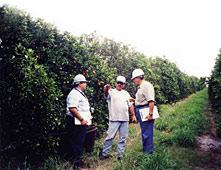 Nationwide, Hispanic and Latino workers make up 15 percent of construction workers, yet they experience 20 percent of constructionrelated fatalities. These statistics are even more alarming in the Fort Lauderdale, FL, area. During the 7 months from October 1, 2001 to May 2, 2002, 30 workers, 17 of them Hispanics or Latinos, died on the job. Five of those killed worked in the construction industry and another five worked in agricultural or landscaping operations. Nationwide, Hispanic and Latino workers make up 15 percent of construction workers, yet they experience 20 percent of constructionrelated fatalities. These statistics are even more alarming in the Fort Lauderdale, FL, area. During the 7 months from October 1, 2001 to May 2, 2002, 30 workers, 17 of them Hispanics or Latinos, died on the job. Five of those killed worked in the construction industry and another five worked in agricultural or landscaping operations.
OSHA's Fort Lauderdale Area Office is waging war against the growing number of Hispanic and Latino workplace fatalities on several fronts. It is a daunting task, trying to protect a largely unskilled workforce that often works in the lowest paid and most hazardous jobs that nobody else wants. Making the job even more difficult is the fact that culturally, this population has been raised to follow their supervisors' instructions without question, often increasing their risk of injury, illness, or death on the job.
To confront this extraordinary problem, the Fort Lauderdale Area Office is coming up with creative new ways to reach out to Hispanic and Latino workers and their employers, and making promising inroads.
The office conducts training sessions in Spanish at local construction companies with a predominantly Spanish-speaking workforce. The office recently conducted another training session, offered in partnership with the Mexican Consulate, that tied occupational safety and health issues with issues covered by the Department of Labor's Wage and Hour Division. In addition, the area office staff was instrumental in getting the largest employers' associations in the Fort Lauderdale area to hire a bilingual safety and health director, already qualified under the OSHA 500 Trainer Course for the Construction Industry, to conduct Spanishlanguage training.
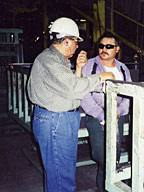 These training sessions have received rave reviews by attendees and have opened doors to increased interaction between workers, employers, and OSHA. Hispanic and Latino workers are beginning to call the office to inquire about safety and health issues, confident that they can talk with staff members who speak their native language and do not pass judgment on their immigration status. To help reinforce this openness, the office's recorded greeting, which plays when the staff is unavailable to answer a call, is recorded in both English and Spanish. Additionally, the office is distributing a Spanish-language videotape, An Introduction to OSHA for the Latino Worker, that gives general guidance about safety and health issues and
how OSHA can help workers and employers alike. This tape, with a written English translation, is being delivered to employers, employee groups, associations, and any others interested. These training sessions have received rave reviews by attendees and have opened doors to increased interaction between workers, employers, and OSHA. Hispanic and Latino workers are beginning to call the office to inquire about safety and health issues, confident that they can talk with staff members who speak their native language and do not pass judgment on their immigration status. To help reinforce this openness, the office's recorded greeting, which plays when the staff is unavailable to answer a call, is recorded in both English and Spanish. Additionally, the office is distributing a Spanish-language videotape, An Introduction to OSHA for the Latino Worker, that gives general guidance about safety and health issues and
how OSHA can help workers and employers alike. This tape, with a written English translation, is being delivered to employers, employee groups, associations, and any others interested.
The Fort Lauderdale Area Office has taken to the airwaves, too, to communicate with the Hispanic and Latino workforce. As office director, I participated in a live radio talk show, telling the audience about services the area office provides and answering questions called in by the audience during the show. As a result of this program, the office receives regular calls from listeners who say they learned about OSHA on the radio and are happy to know that they can get help in their native language. The office is arranging to participate in more of these forums to get its message out to more Hispanics and Latinos.
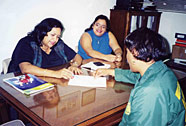 In the office, the staff meets regularly with Spanish-speaking immigrant groups to build relationships and establish the climate of trust needed to work cooperatively to reduce injury and fatality rates among Hispanic and Latino workers. The staff also sends a bilingual staff whenever possible to inspect workplaces with a large percentage of Hispanic or Latino workers. During inspections, the compliance staff contacts several of these workers to ensure they understand their rights and protections under the Occupational Safety and Health Act. In addition, the office's Construction Accident Reduction Emphasis, or CARE, program has been extremely successful in reaching this working segment. Established in March 1999, this program, as well as local emphasis programs focused on preventing
falls and overhead power-line accidents, has helped reduce fatality rates among Hispanic and Latino workers. In the office, the staff meets regularly with Spanish-speaking immigrant groups to build relationships and establish the climate of trust needed to work cooperatively to reduce injury and fatality rates among Hispanic and Latino workers. The staff also sends a bilingual staff whenever possible to inspect workplaces with a large percentage of Hispanic or Latino workers. During inspections, the compliance staff contacts several of these workers to ensure they understand their rights and protections under the Occupational Safety and Health Act. In addition, the office's Construction Accident Reduction Emphasis, or CARE, program has been extremely successful in reaching this working segment. Established in March 1999, this program, as well as local emphasis programs focused on preventing
falls and overhead power-line accidents, has helped reduce fatality rates among Hispanic and Latino workers.
These are just a few examples of the activities the Fort Lauderdale Area Office is involved in in its ongoing effort to help protect Hispanic and Latino workers. Although the fatality rates may be starting to dip, one death is still one too many. For more information or to offer suggestions, contact the area office at (954) 232-2895. |
| The office is coming up with creative new ways to reach out to Hispanic and Latino workers and their employers, and making promising inroads. |
| Santiago is the Director of the OSHA Fort Lauderdale Area Office. |
|
|
|
